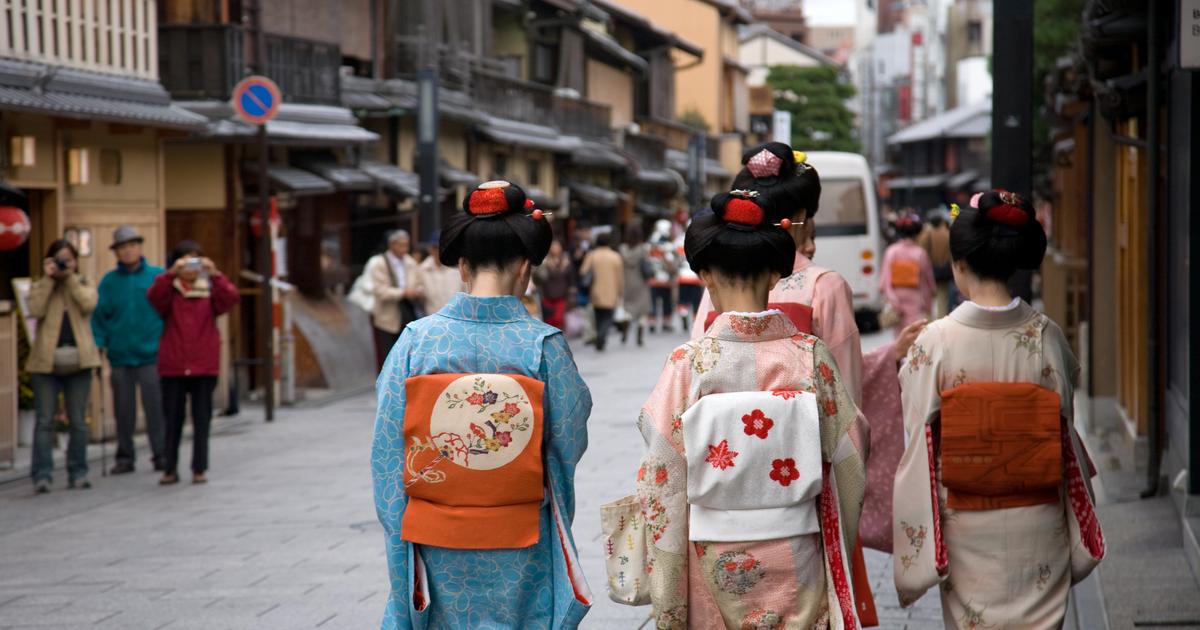From autumn until the arrival of spring, the gardens of
Japan
are filled with curious structures of bamboo and rope on the tops of the
trees
.
An iconic print that, beyond its beauty, plays an essential role in protecting plants against the ravages of
snow
.
These conical supports are formed by a central bamboo pole, placed parallel to the main trunk of the tree or bush.
From this axis, as many chords are radially stretched as there are primary branches of the plant.
Like a sling, each rope is tied to the end of a branch, at the exact point that ensures its resistance against the weight of snow or ice.
For larger specimens, such as the mythical Karasaki pines in the
Kenrokuen
gardens
, up to 800 rope ties can be used.
This type of tree, with a careful and characteristic pruning reminiscent of that of bonsai, is also propped up from below by poles resting on the ground that relieve the weight of the more horizontal branches, even those that rest on ponds.
This technique is more common in areas with heavy snowfall, such as Toyama, Ishikawa, and Fukui prefectures along the coast of the Sea of Japan, or in the Tohoku and Hokuriku regions in the north of the country.
In a symbolic way it is also installed in the capital, Tokyo, where the probability of snowfall is much lower.
Each tradition around the garden has a sonorous name in Japan.
Hanami
is the term they use to observe the flowering in spring, specifically of the cherry trees (
sakura
) and
momiji
(name of the maple leaves) to contemplate the autumn.
The art of the
Yukitsuri
(or
Yuki-tsuri
), whose literal translation would be "snow braces", is one of the most colorful customs of the Japanese garden culture.
It has been used since the 17th century and its origin seems to be found in the way in which the first apple trees arrived from Europe were protected from the weight of their fruits.
But this is not the only resource of a people that does not skimp on care for the protection of its arboreal heritage.
The
Yuki-gakoi
is a complementary method to the braces with which the trunks and branches are covered with straw to protect them from snow and frost.
The mats prevent cold and moisture from penetrating the roots and base of the stem, thus preventing winter excesses from leading to wasting and disease.
Are these techniques possible in Madrid?
According to data from the City Council, at the moment, 150,000 of the 800,000 trees that are located in green areas, streets and squares of the city have been affected.
This means that one in five trees (20%) are damaged by snow.
Regarding historical parks, this percentage rises to 68% (around 32,500 trees), 12% in unique parks (64,140) and 403,000 in Casa de Campo, where more than 64% could have significant damage.
Filomena's devastating passage has caused the council to close indefinitely all the parks in the city until the Environment services manage to restore normalcy.
The same is true of the Royal Botanical Garden, which has announced that it will be closed for at least two weeks.
After the fateful effects of the Filomena snowstorm on the trees in
Madrid
, is it possible to consider the application of winter prevention and protection measures such as those taken in the Japanese country?
The usefulness of these Japanese techniques in a city like Madrid seems unlikely, especially in tree-lined roads –for obvious reasons of space– and because a disproportionate contribution of resources would be required for such a low probability of snowfall.
It could make sense, in any case, about the unique trees of the city - cataloged or not - such as the ahuehuete (
Taxodium huegeli
) of the Retiro or the
hackberry
(
Celtis australis
) of the Paseo del Prado, although the latter already has a strap system to prevent breakage due to advanced age.
Fast-growing trees, invaders or victims of pollution
Despite the exceptional nature of this storm, the devastating image of the streets and parks of Madrid, with hundreds of fallen trees and thousands of broken branches, could have been largely avoided if there were a global management plan for urban trees. , raised in the long term, that would prevent these situations and ensure a healthy population resistant to the constraints of the capital.
Current plans do not include, among their essential measures, a selection of species that is diverse and suitable for the often extreme temperatures of the city.
It is true that few trees adapted to the continentalized Mediterranean climate –such as Madrid's– would endure 30 hours of continuous snowfall, but it is also logical to take into account, for example, that evergreen species accumulate more snow or that their branches full of leaves exert more resistance against strong winds.
The structure of the glasses also determines their resistance.
Pyramidal, conical, or columnar shapes help snow stay on the tree for less time.
This is the case of the Himalayan cedar (
Cedrus deodara
) very present in Madrid, whose branches have the ends inclined downwards, an adaptation that allows it to get rid of the weight of the snow.
Most of the specimens affected by Filomena belong to
fast-growing species that develop light branches and weak wood, such
as the privet (
Ligustrum japonicum
) or the Japanese acacia (
Sophora japonica
), very common in the streets of Madrid.
However, in recent years other particularly resistant species - albeit with invasive potential - have been gaining ground, such as the flowering pear tree (
Pyrus calleryana
) with which the new tree pits on Gran Vía or Chueca were planted, for example.
Although Madrid was recognized as the 2019 Tree City of the World by FAO and the Arbor Day Foundation, its streets are full of trees affected by pollution or human aggression.
Many of them have disproportionate sizes because the scale and the maximum development they can reach have not been taken into account.
Many others grow spindly due to the shadow cast by the buildings and stretch their branches in an exaggerated way in search of light, which makes them much more fragile.
When many trees are too many
Madrid has almost a million and a half trees between its streets and green areas (645,316) and parks (785,732), according to 2019 City Council data, which places it in the upper area of
world
rankings
(depends on the study) .
Something that
a priori
may seem worthy of municipal pride leads to overpopulation.
It occurs, above all, in parks such as Casa de Campo, with almost 700,000 trees, whose successive repopulations have not respected the planting framework that indicates the necessary separation for the plants to develop normally.
These density limits are necessary so that the trees have optimal living space and do not compete with each other for sunlight or for water and soil nutrients.
The consequence of this demographic excess is the formation of very thin trunks and branches that are therefore fragile when faced with breakage by wind or snow.
On the other hand,
the roots of the trees are one of the aspects most abused by current urban planning.
The tree pits do not usually have the width or the contribution of organic matter necessary for the roots to deepen and the substrate is often compacted or continuously flooded, when they are not empty or with old stumps.
Most are blocked by materials such as concrete or granite, which do not allow perspiration or the entry of oxygen.
All these factors weaken the support of the trees and can lead to hypoxic death of the roots.
In Madrid it is very common to find grass meadows planted with pine trees or other species that receive sprinkler irrigation, as is the case of the gardens of the Puente de Segovia or those of the Nuevos Ministerios complex.
This superficial irrigation, as opposed to the localized one by dripping, causes that the roots do not develop downwards in search of moisture and therefore their grip on the ground is minimal.
But pruning is the main pending subject of urban gardening in Spain.
The image of large topped plane trees is very common in streets and squares throughout the country.
While in other places like Japan, pruning is a whole culture and well planned and gentle interventions are carried out that do not put the resistance of trees to the limit, in Spain it is traditionally thought that the more you prune, the less risk of fractures there is.
Moderate cleaning pruning that respects the natural structure of the tree, and ensures that it remains strong and does not bend to inclement weather.
The effects of Filomena on the trees will also be seen in the long term.
The
salt that is used in industrial quantities as snow flux can end up killing a large number
of Madrid's
battered trees
.
Although during these days the collateral damage that sodium chloride causes in nature is not noticed, several scientific studies show that the salt that ends up on the roadsides and in the tree pits ends up affecting the roots and limiting their absorption capacity of nutrients.
It will also reach aquifers, streams and rivers, altering the PH of the water and causing damage to flora and fauna over time.
To try to avoid this, a group of Canadian scientists propose the application of alternative methods, such as beet juice from the residues of the sugar industry.







